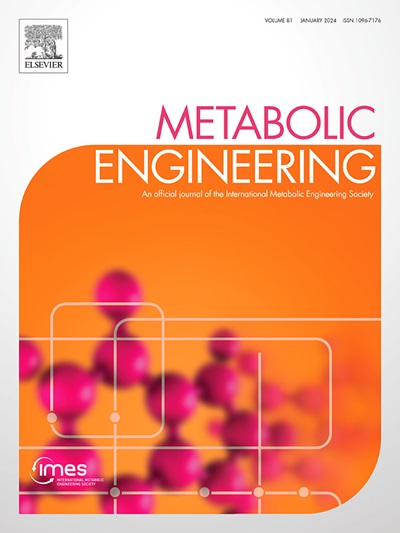Tailoring Escherichia coli for high-yield production of O-acetyl-L-homoserine through multi-node metabolic regulation
IF 6.8
1区 生物学
Q1 BIOTECHNOLOGY & APPLIED MICROBIOLOGY
引用次数: 0
Abstract
O-acetyl-L-homoserine (OAH) is a key precursor for the biosynthesis of L-methionine and various C4 compounds, with significant industrial potential. However, efficient microbial production of OAH remains challenging due to complex metabolic regulation and precursor limitations. In this study, we rationally developed a plasmid-free, non-auxotrophic Escherichia coli strain to produce OAH. We modularized the OAH synthetic pathway into L-homoserine and acetyl-CoA modules, enhanced each module individually, and identified a highly efficient L-homoserine O-acetyltransferase (MetX) from Cyclobacterium marinum. Using small RNA screening, we pinpointed critical metabolic nodes and fine-tuned the pathway flux through promoter engineering and regulatory elements. Notably, we balanced the acetyl-CoA and L-homoserine synthesis with moderate expression of pyruvate carboxylase, weakened the TCA cycle by modulating citrate synthase and the branched-chain amino acid pathway by attenuating BCAA aminotransferase, thereby redirecting carbon flux towards OAH production. Additionally, we optimized the threonine attenuator for dynamic regulation of the threonine pathway and enhanced intracellular ATP turnover. Under a two-stage pH control fermentation strategy, the final plasmid-free and non-auxotrophic strain OAH37 achieved a titer of 94.1 g/L OAH, with a yield of 0.42 g/g glucose and a productivity of 1.37 g/L/h. Our work demonstrates the potential of metabolic engineering strategies for efficient microbial synthesis of OAH, providing a foundation for industrial-scale production of this important precursor.
通过多节点代谢调节使大肠杆菌高产o -乙酰- l-高丝氨酸
o -乙酰- l-高丝氨酸(OAH)是生物合成l-蛋氨酸和各种C4化合物的关键前体,具有重要的工业潜力。然而,由于复杂的代谢调节和前体的限制,高效的微生物生产OAH仍然具有挑战性。在这项研究中,我们合理地开发了一种无质粒、非营养大肠杆菌菌株来生产OAH。我们将OAH合成途径模块化为l-高丝氨酸和乙酰辅酶a模块,并分别对每个模块进行增强,从海洋环杆菌中鉴定出高效的l-高丝氨酸o -乙酰转移酶(MetX)。通过小RNA筛选,我们确定了关键的代谢节点,并通过启动子工程和调控元件微调了途径通量。值得注意的是,我们通过适度表达丙酮酸羧化酶来平衡乙酰辅酶a和l-高丝氨酸的合成,通过减弱BCAA转氨酶来调节柠檬酸合成酶和支链氨基酸途径,从而减弱TCA循环,从而将碳通量重定向到OAH的产生。此外,我们优化了苏氨酸衰减器,以动态调节苏氨酸途径并增强细胞内ATP的周转。在两阶段pH控制发酵策略下,最终无质粒、非营养不良菌株OAH37的OAH滴度为94.1 g/L,产率为0.42 g/g葡萄糖,产率为1.37 g/L/h。我们的工作证明了代谢工程策略在高效微生物合成OAH方面的潜力,为这种重要前体的工业规模生产提供了基础。
本文章由计算机程序翻译,如有差异,请以英文原文为准。
求助全文
约1分钟内获得全文
求助全文
来源期刊

Metabolic engineering
工程技术-生物工程与应用微生物
CiteScore
15.60
自引率
6.00%
发文量
140
审稿时长
44 days
期刊介绍:
Metabolic Engineering (MBE) is a journal that focuses on publishing original research papers on the directed modulation of metabolic pathways for metabolite overproduction or the enhancement of cellular properties. It welcomes papers that describe the engineering of native pathways and the synthesis of heterologous pathways to convert microorganisms into microbial cell factories. The journal covers experimental, computational, and modeling approaches for understanding metabolic pathways and manipulating them through genetic, media, or environmental means. Effective exploration of metabolic pathways necessitates the use of molecular biology and biochemistry methods, as well as engineering techniques for modeling and data analysis. MBE serves as a platform for interdisciplinary research in fields such as biochemistry, molecular biology, applied microbiology, cellular physiology, cellular nutrition in health and disease, and biochemical engineering. The journal publishes various types of papers, including original research papers and review papers. It is indexed and abstracted in databases such as Scopus, Embase, EMBiology, Current Contents - Life Sciences and Clinical Medicine, Science Citation Index, PubMed/Medline, CAS and Biotechnology Citation Index.
 求助内容:
求助内容: 应助结果提醒方式:
应助结果提醒方式:


